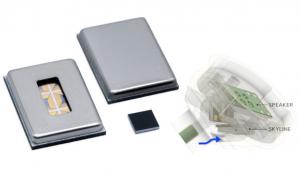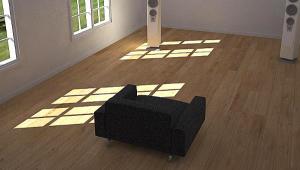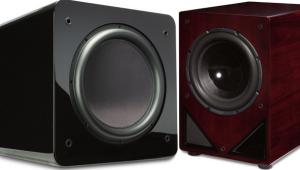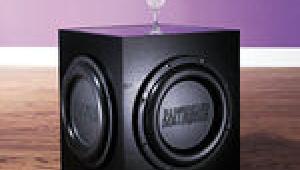Dr. Poh Hsu, Founder, Hsu Research
 Dr. Poh Hsu has a doctorate in civil engineering from MIT, but his passion for audio and experiments in subwoofer design led him to found his own speaker company in 1991. His subs quickly earned a reputation for high output, outstanding sound quality and great value, and he’s still at it today. Excerpts from this interview appear in the feature story “Subwoofers: The Guts and the Glory.”
Dr. Poh Hsu has a doctorate in civil engineering from MIT, but his passion for audio and experiments in subwoofer design led him to found his own speaker company in 1991. His subs quickly earned a reputation for high output, outstanding sound quality and great value, and he’s still at it today. Excerpts from this interview appear in the feature story “Subwoofers: The Guts and the Glory.”
S&V: What do you believe are the major determiners of subwoofer sound quality? Driver? Amp? Loading? Enclosure? DSP tuning? Etc.
PH: It is how they are all designed to work together synergistically. No one factor stands out.
S&V: What drives your decision to go with sealed, ported, or passive radiator loading in a particular sub? Is one or the other particularly suited for a certain environment, a certain type of program material, or a certain taste in sound?
PH: Whenever possible, I try to design my subwoofers so the end user can choose the tuning that they prefer. I try to give them as many options as possible. Personal taste, room size and shape, adjoining room size and shape, placement location, seating position, program material—all affect what tuning best suits each end user.
All of our VTF subwoofers let the consumer choose from three modes: two ports open, one port open or sealed. There’s an EQ switch on the sub that tunes the response to suit the different modes.
When customers call up and ask for a recommendation on which alignment to use, usually I ask what kind of sound they like. Normally my recommendation is that if you like really good, very low-frequency output, definitely you want to go with the one port open mode. If they like the highest possible headroom, go with two ports open mode. If for some reason, that would be kind of strange to me, they would want to go with sealed … sealed does have a certain sound quality, it may be a little tighter, but output capability at low frequency is limited. My philosophy is, give customers the full range of options, so almost any customer can get what they’re looking for.
S&V: How do you feel about minisubs—small subwoofers that use high-excursion drivers and high-powered amps to get deep extension and high output? Can a minisub equal the performance of a conventional, larger sub?
PH: In my opinion, size matters. With good engineering, one can get a minisub to work reasonably well, at the expense of reliability and cost.
Most of those subs use a passive radiator, because if you used a port in such a small enclosure it would have to be about a half-inch in diameter and it would whistle like crazy. But a passive radiator in a small enclosure can cause problems, too. For a passive radiator to be tuned low in a small cabinet, you need a really heavy diaphragm and very high excursion, so you could have a reliability problem.
S&V: What measurements do you perform when evaluating a subwoofer design? Which do you think are most important?
PH: I do CEA-2010, frequency response, compression, and distortion. But listening is more important than any of them.
Because I usually try to design very cost-effective subs, I will have an idea of the budget range I’m aiming for, so I need to have a handle on what the production cost might be. I have a target bass extension and a target output capability, and that’s what I’ll be shooting for in the measurements.
When I design a driver, I make sure the Xmax [maximum excursion] and all that will give me the SPL I’m hoping to get. Sometimes the drivers aren’t always on target and we have to go through a few iterations. Then I put the driver in the cabinet I designed, and do a frequency response with the raw woofer in the cabinet—no EQ or anything. Usually the simulation I do on the computer comes extremely close. Then I do CEA-2010—although I can do that before you do the EQ, since I’m mainly checking to see if the amplifier has enough oomph to hit the target.
S&V: What goals do you set when you tune the digital signal processors on your subwoofers? Do you make the response flat, or do you put in bumps in the response to give the sub a certain sound?
PH:: I don’t use DSP, I do the tuning in analog circuitry. For vented tuning, I prefer to use 6th order [36 dB/octave] tuning with electronic contouring. I generally go for flat response, so the sub goes down about 1/3rd octave lower than the –3 dB point for the driver. I use a relatively low-Q driver. In order for it to extend 1/3rd octave lower, you have to boost it in the electronics, but acoustically it’s flat. Then we have a subsonic filter that cuts off the response steeply below the port resonance.
"I don’t use DSP, I do the tuning in analog circuitry."
I don’t believe in having different sound modes or EQ modes. A subwoofer should be accurate. You should aim for that no matter what material you play.
S&V: What recommendations do you have for integrating your subs with a 5.1 system? Does the crossover in a typical A/V receiver usually get the job done well?
PH: I feel where you sit in the room and where you place the sub are critical in getting the sub to sound best, including integrating it into your system. I always suggest doing a subwoofer crawl [putting the subwoofer in your listening chair then crawling around on the floor to find the spot where bass is smoothest] to determine the best spot to place the subwoofer. If your system has equalization capabilities, find the location that gives the highest output in the low bass without any major weakness in the upper bass. That would give you the highest headroom and lowest distortion. If you do not have EQ capabilities, find the spot that gives you the smoothest response.
Once the best location is chosen, one can either use the receiver/controller’s auto calibration to tune, or use our provided CD and a SPL meter to set subwoofer level. With our multiple tuning subs, we recommend setting them to max extension mode, Q 0.7—the flattest mode—for auto calibration so the auto calibration corrects for the room effects only. After that, selecting different Q or tuning modes will allow you to hear the full effect of the subwoofer’s controls in altering the sound character.
I generally recommend crossing over at 80 Hz, assuming all the speakers can go that low, even if your main speakers have can play lower. That usually yields wider dynamic range out of your system and keeps localization of the sub to a minimum. If one has to cross over higher, placing the sub between the front left and right speakers will help minimize localization.
S&V:S&V: How about for a stereo system? Almost no two-channel preamps or integrated amps have subwoofer outputs or crossover circuitry.
PH: I highly recommend they get one of our electronic crossovers. We have two models, a high-end $459 model with 24 dB/octave Linkwitz Riley high-pass and low-pass filters, and a simpler $100 model with a 12 dB/octave high-pass filter only. You can connect these between the preamp and power amp, or in the preamp output/power amp input loop of an integrated amp or stereo receiver. These will keep the distortion low in the main speakers because they’ll filter out the deep bass so only the subwoofer handles it. It also relieves your main amp from having to handle the bass, which increases the headroom of the amp—so it’ll play louder before running out of steam.
Of course, when you talk to some of the high-end folks, they want as little in the signal chain as possible. So for folks who don’t want a high-pass filter, just use test tones or measurements to determine how low the main speakers go. If they start sounding weak at 50 Hz, bring the subwoofer in at 50 Hz.
S&V:: Do you have a certain Q [resonance bandwidth] that you prefer?
PH: We have Q knob because based on what I see from customer preference, some people like an over damped subwoofer with very gentle roll-off in bass response. That category of people, I feel that they like hearing a little more of the overtones relative to the fundamental, and that’s what lower Q does. I don’t like the idea of creating a sub that will have boomy bass, so we allow a maximum Q of 0.7, which is flat. The lowest we go is 0.3. That’s just purely a personal thing.
S&V: Would you recommend S&V readers buy four smaller subs, two midsized subs or one large sub, if the price for the different packages were about the same?
PH: Generally, I recommend going with one bigger sub. My main philosophy behind that is, the bigger sub is the one that will go lower. I know there are a lot of people who advocate using multiple subs for more even distribution of bass through the listening area. There’s some merit to that. But in most families, many people don’t like that much bass, so it’s good to have some seats with less bass than others! Like, “Honey, I don’t like all this bass.” “OK, go sit in this seat.” If you always sit in one seat to listen, I would optimize the bass for that one seat. Usually when you do multiple subwoofers, every seat is OK, but there’s no really great seat, and you’re trading off headroom.
"I recommend going with one bigger sub. My main philosophy behind that is, the bigger sub is the one that will go lower."
S&V: Any particular recommendations for a smaller room?PH: Yes, don’t assume you should get a smaller subwoofer for a smaller room. Usually what I tell people is, you can never have too big a sub. It sounds like advertising spiel, but it’s true. You never need to set a sub louder than you want to, so it never needs to be overwhelming. With a larger sub, for the same listening level you get lower distortion and more headroom than with a smaller sub, so it sounds cleaner and more dynamic. When you have a bigger sub, it’s a lot less stressed at the same listening level, and that usually translates to better long-term reliability.
Unless of course the spouse acceptance factor comes into play. Then you go with the smaller sub.
S&V: How do you feel about high-efficiency subwoofer amplifier technologies, such as Class D, Class G, and Class H? Do you feel a traditional Class AB amp offers better sound? Or do you feel Class AB is still viable?
PH: Further down the road there’s the possibility they’ll come up with something I’m happy with. But most of the Class D amps I’ve looked at have a poor damping factor [the ratio of the impedance of the speaker, typically 8 ohms, to the output impedance of the amplifier] because they have a high-frequency choke to keep high frequencies of the switching circuitry from getting out. Especially with subs, I feel the vast majority of damping is coming from the amplifier, so I don’t like using an amp that doesn’t have a good damping factor. It should at least be in the 50 to 100 range. So I feel Class AB still seems to make the most sense. A Class D power supply is fine, though. If I come across a Class D amp with a good damping factor, I’d be happy to try it out. I have no problem at all with G or H, because those are just Class AB with multiple rails. My old cylindrical tube subs had a Class G amp, and we’re using BASH amps now with switching power supplies that track the incoming signal.





















































